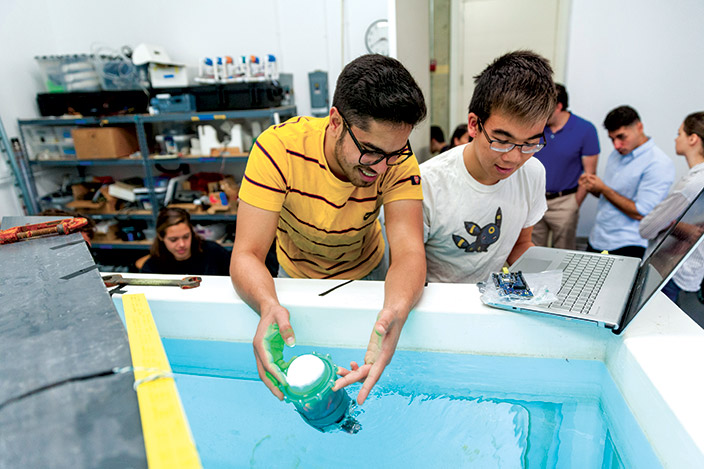Clinic Program
Local, International, Extraterrestrial
THE 55TH PROJECTS DAY WAS A SHOWCASE OF RESULTS FROM 48 CLINIC projects in the disciplines of engineering, computer science, mathematics and physics. A total of 260 students contributed more than 50,000 hours seeking solutions to problems for corporate, national laboratory and agency sponsors. Areas of focus ranged from creating 3-D sound systems to improving photovoltaic panels to producing surface treatments for aircraft engines and more. Here are details about a few of the projects.
Computer Science Clinic: Better Driving Through AR
Mercedes-Benz Research & Development North America
Liaisons: Mark Poguntke, Kavita Saney, Jeff Bertalotto
Advisor: Professor Geoff Kuenning
Students: Julio Medina ’18, Drew Summy ’18, Aman Raghuvanshi CMC ’18, Meredith Simpson POM ’18

This project explored the possibility of using augmented reality (AR) while driving a car. The team compared various AR headsets, and built a functioning prototype to address a moving car use-case. The headset comparison involved testing devices in a stationary and moving vehicle and understanding their respective development experiences. The resulting prototype application attempts to help drivers park more safely and precisely and serves as a starting point for the Mercedes-Benz team for an extendable AR headset prototyping framework.
Mathematics Clinic: Experiencing Sports
Intel Sports
Liaisons: Cody Gabriel, Peter Sankhagowit, Steven Xing
Advisor: Weiqing Gu
Students: Daniel Johnson ’18, Daniel Gorelik ’18, Ross Mawhorter ’19, Kyle Suver ’18

Football and basketball fans are familiar with Intel’s TrueView technology, which reconstructs three-dimensional video using multiple video recordings. However, this system doesn’t extend to audio. Students were tasked with devising an approach to reconstruct game audio at any location based on microphone recordings to combine with the current volumetric video system. After exploring existing algorithms for sound source separation and localization, the team developed a prototype system called auVVio that extends these techniques to interactively reconstruct game sounds in 3-D.
Engineering Clinic: Aerospace Wear Coatings
Meggitt Control Systems
Liaisons: Leo Leyanna, Mark Abrams
Advisor: Professor Gordon Krauss
Students: Kristin Lie ’18, Jacob Knego ’18, Briana Liu ’19, William Teav ’19, Alex Ravnik ’19, Zach Goland ’19, Fernando Fernandez ’18
Meggitt Control Systems produces a variety of products for extreme environments. The Clinic team was tasked with researching, testing and characterizing low-cost, environmentally friendly surface treatments to reduce wear on a butterfly bleed-air valve. These valves are used in aircraft engines and must withstand high temperatures while experiencing as little wear as possible over 50,000 cycles.
Engineering Clinic: Let There Be Light Shows
WET Liaisons: Scott Winslow, Helen Park, Markos Okihisa
Advisors: Professor Matthew Spencer
Students: Elijah Carbonaro ’18, Kimberly Joly ’18, Hamza Khan ’18, Trevor Fung ’19, Gabriel Quiroz ’19, Shiv Seetharaman ’18, Lydia Sylla ’19, Felipe Borja ’19

The WET Clinic team built a fleet of small aquatic robots to perform light shows. The shows are choreographed via a computer vision system that can precisely localize the pods and a multilink Bluetooth low-energy system to communicate with the pods. The fleet of pods uses multi-robot trajectory planning algorithms to move in a choreographed sequence.
Engineering/Clinic: Local Hot Spot
Claremont Locally Grown Power
Liaisons: Kent Kernahan, Devon Hartman Advisors: Professors Qimin Yang, Tom Donnelly, Peter Saeta and Dick Haskell
Students: Jonathan Kupfer ’18, Florence Walsh ’18, Quentin Barth ’18, Dallon Asnes POM ’18, William Lamb POM ’18

The Clinic team sought to help Claremont Locally Grown Power achieve its goal of outfitting lowerto middle-income households with cheaper, safer and more efficient solar panels. Students performed lab research, physics-based mathematical modeling and prototype comparison field studies intended to provide third-party verification and testing of the underlying idealPV technology in panels.
Global Clinic: Green Infrastructure Solutions for Urban Flooding in Kibera, Nairobi, Kenya
Kounkuey Design Initiative
Liaisons: Chelina Odbert, Joe Mulligan, Vera Bukachi
Advisor: Professor Ziyad Duron ’81
Students: Isabel King ’18, Camille Croll ’18, Manu Kondapi ’18, Andrea Vasquez ’18, Eric Contee II ’19, Eliana Goehring ’19

Kibera is a large, informal settlement in Nairobi, Kenya, where annual flash flooding causes significant health, economic and structural problems. Current drainage infrastructure consists of informal channels that are not designed to handle the volume of water that falls during large rain events. The objective of this project was to work with the community to develop practical design improvements for the existing drainage channels that can be implemented in Kibera, to improve quality of life for residents.
In March 2018, the students and engineering professor Matthew Spencer visited Kibera. The team hosted a community workshop and consulted with Kounkuey Design Initiative employees to develop successful experiments with implications for the design of future channels. The experiments would be carried out later, once the team returned home.
“The community workshop that the team ran was one of the high points of my Clinic experiences,” says Spencer. “It was a really good opportunity to learn about community-centered design by participating in it. The Kounkuey Design Initiative team was awesome, and their investment of time really helped the students navigate the site visits.”